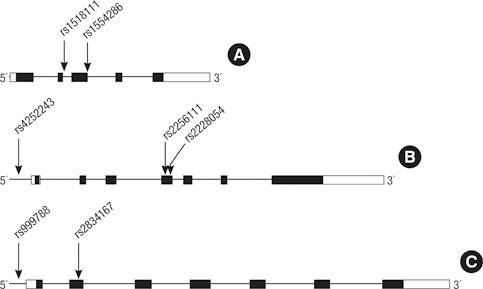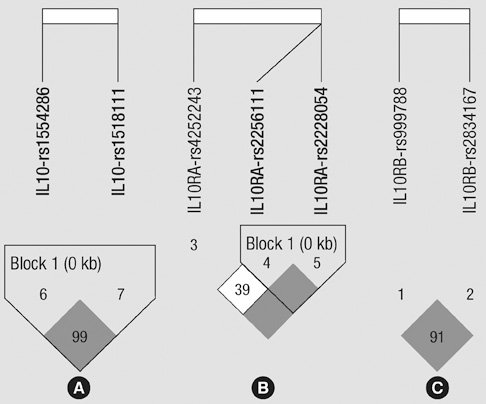J Korean Med Sci.
2011 May;26(5):659-664. 10.3346/jkms.2011.26.5.659.
Association of IL10, IL10RA, and IL10RB Polymorphisms with Benign Prostate Hyperplasia in Korean Population
- Affiliations
-
- 1Department of Urology, School of Medicine, Kyung Hee University, Seoul, Korea. sgchang@khu.ac.kr
- 2Kohwang Medical Research Institute, School of Medicine, Kyung Hee University, Seoul, Korea.
- KMID: 1777866
- DOI: http://doi.org/10.3346/jkms.2011.26.5.659
Abstract
- Cytokines such as interleukin 10 (IL10) may play an important role in the process of inflammation. The aim of this study was to analyze the association between IL10, IL10RA and IL10RB single nucleotide polymorphisms (SNPs), and benign prostate hyperplasia (BPH) in Korean population. All patients with BPH were divided into two groups according to international porostate symptom score (IPSS), prostate specific antigen (PSA) level, Qmax, and prostate volume. We selected two IL10 SNPs (rs1518111 and rs1554286), three IL10RA SNPs (rs2256111, rs4252243, and rs2228054), and two IL10RB SNPs (rs999788 and rs2834167). Genotypes of seven SNPs were determined through direct sequencing. The G/G genotype of IL10RB polymorphism (rs2834167) was associated with a high PSA level compared with the A/G + A/A genotypes (P = 0.009). Of IL10 SNP, the A/A genotype of rs1518111 and T/T genotype of rs1554286 were associated with small prostate volume, respectively (P = 0.011, P = 0.014). Moreover, the T/T genotype of IL10RB polymorphism (rs999788) was associated with high prostatic volume compared with the T/C + C/C genotypes (P = 0.033). The linkage disequilibrium (LD) blocks were formed in IL10 and IL10RA. However, haplotypes in the LD block were not associated with BPH. It is concluded that there is a strong association between the IL10 and IL10RB SNPs, and BPH in Korean population.
MeSH Terms
-
Aged
*Genetic Predisposition to Disease
Genotype
Humans
Inflammation
Interleukin-10/*genetics
Interleukin-10 Receptor alpha Subunit/*genetics
Interleukin-10 Receptor beta Subunit/*genetics
Linkage Disequilibrium
Male
Middle Aged
*Polymorphism, Single Nucleotide
Prostate-Specific Antigen/blood/genetics
Prostatic Hyperplasia/*genetics
Republic of Korea
Sequence Analysis, DNA
Figure
Reference
-
1. Park HK, Park H, Cho SY, Bae J, Jeong SJ, Hong SK, Yoon CY, Byun SS, Lee SE, Kim KW. The prevalence of benign prostatic hyperplasia in elderly men in Korea: a community-based study. Korean J Urol. 2009. 50:843–847.2. Kramer G, Mitteregger D, Marberger M. Is benign prostatic hyperplasia (BPH) an immune inflammatory disease? Eur Urol. 2007. 51:1202–1216.3. Konwar R, Gara R, Singh M, Singh V, Chattopadhyay N, Bid HK. Association of interleukin-4 and interleukin-1 receptor antagonist gene polymorphisms and risk of benign prostatic hyperplasia. Urology. 2008. 71:868–872.4. Robinette CL. Sex-hormone-induced inflammation and fibromuscular proliferation in the rat lateral prostate. Prostate. 1988. 12:271–286.5. Kramer G, Steiner GE, Handisurya A, Stix U, Haitel A, Knerer B, Gessl A, Lee C, Marberger M. Increased expression of lymphocyte-derived cytokines in benign hyperplastic prostate tissue, identification of the producing cell types, and effect of differentially expressed cytokines on stromal cell proliferation. Prostate. 2002. 52:43–58.6. He L, Wang Y, Long Z, Jiang C. Clinical significance of IL-2, IL-10, and TNF-alpha in prostatic secretion of patients with chronic prostatitis. Urology. 2010. 75:654–657.7. Konwar R, Chattopadhyay N, Bid HK. Genetic polymorphism and pathogenesis of benign prostatic hyperplasia. BJU Int. 2008. 102:536–544.8. Kaplan SA, McConnell JD, Roehrborn CG, Meehan AG, Lee MW, Noble WR, Kusek JW, Nyberg LM Jr. Medical Therapy of Prostatic Symptoms (MTOPS) Research Group. Combination therapy with doxazosin and finasteride for benign prostatic hyperplasia in patients with lower urinary tract symptoms and a baseline total prostate volume of 25 ml or greater. J Urol. 2006. 175:217–220.9. Siami P, Roehrborn CG, Barkin J, Damiao R, Wyczolkowski M, Duggan A, Major-Walker K, Morrill BB. CombAT study group. Combination therapy with dutasteride and tamsulosin in men with moderate-to-severe benign prostatic hyperplasia and prostate enlargement: the CombAT (Combination of Avodart and Tamsulosin) trial rationale and study design. Contemp Clin Trials. 2007. 28:770–779.10. Lewis CM. Genetic association studies: design, analysis and interpretation. Brief Bioinform. 2002. 3:146–153.11. Barrett JC, Fry B, Maller J, Daly MJ. Haploview: analysis and visualization of LD and haplotype maps. Bioinformatics. 2005. 21:263–265.12. Bagnoli S, Cellini E, Tedde A, Nacmias B, Piacentini S, Bessi V, Bracco L, Sorbi S. Association of IL10 promoter polymorphism in Italian Alzheimer's disease. Neurosci Lett. 2007. 418:262–265.13. Deans DA, Tan BH, Ross JA, Rose-Zerilli M, Wigmore SJ, Howell WM, Grimble RF, Fearon KC. Cancer cachexia is associated with the IL10 -1082 gene promoter polymorphism in patients with gastroesophageal malignancy. Am J Clin Nutr. 2009. 89:1164–1172.14. Heiskanen M, Kähönen M, Hurme M, Lehtimäki T, Mononen N, Juonala M, Hutri-Kähönen N, Viikari J, Raitakari O, Hulkkonen J. Polymorphism in the IL10 promoter region and early markers of atherosclerosis: the Cardiovascular Risk in Young Finns Study. Atherosclerosis. 2010. 208:190–196.15. Huang S, Xie K, Bucana CD, Ullrich SE, Bar-Eli M. Interleukin 10 suppresses tumor growth and metastasis of human melanoma cells: potential inhibition of angiogenesis. Clin Cancer Res. 1996. 2:1969–1979.16. Kundu N, Beaty TL, Jackson MJ, Fulton AM. Antimetastatic and antitumor activities of interleukin 10 in a murine model of breast cancer. J Natl Cancer Inst. 1996. 88:536–541.17. Stearns ME, Rhim J, Wang M. Interleukin 10 (IL-10) inhibition of primary human prostate cell-induced angiogenesis: IL-10 stimulation of tissue inhibitor of metalloproteinase-1 and inhibition of matrix metalloproteinase (MMP)-2/MMP-9 secretion. Clin Cancer Res. 1999. 5:189–196.18. Mullan RJ, Bergstralh EJ, Farmer SA, Jacobson DJ, Hebbring SJ, Cunningham JM, Thibodeau SN, Lieber MM, Jacobsen SJ, Roberts RO. Growth factor, cytokine, and vitamin D receptor polymorphisms and risk of benign prostatic hyperplasia in a community-based cohort of men. Urology. 2006. 67:300–305.19. Howell WM, Rose-Zerilli MJ. Interleukin-10 polymorphisms, cancer susceptibility and prognosis. Fam Cancer. 2006. 5:143–149.20. McCarron SL, Edwards S, Evans PR, Gibbs R, Dearnaley DP, Dowe A, Southgate C, Easton DF, Eeles RA, Howell WM. Influence of cytokine gene polymorphisms on the development of prostate cancer. Cancer Res. 2002. 62:3369–3372.21. Eder T, Mayer R, Langsenlehner U, Renner W, Krippl P, Wascher TC, Pummer K, Kapp KS. Interleukin-10 [ATA] promoter haplotype and prostate cancer risk: a population-based study. Eur J Cancer. 2007. 43:472–475.22. Xu J, Lowey J, Wiklund F, Sun J, Lindmark F, Hsu FC, Dimitrov L, Chang B, Turner AR, Liu W, Adami HO, Suh E, Moore JH, Zheng SL, Isaacs WB, Trent JM, Grönberg H. The interaction of four genes in the inflammation pathway significantly predicts prostate cancer risk. Cancer Epidemiol Biomarkers Prev. 2005. 14(11 Pt 1):2563–2568.23. Michaud DS, Daugherty SE, Berndt SI, Platz EA, Yeager M, Crawford ED, Hsing A, Huang WY, Hayes RB. Genetic polymorphisms of interleukin-1B (IL-1B), IL-6, IL-8, and IL-10 and risk of prostate cancer. Cancer Res. 2006. 66:4525–4530.24. Faupel-Badger JM, Kidd LC, Albanes D, Virtamo J, Woodson K, Tangrea JA. Association of IL-10 polymorphisms with prostate cancer risk and grade of disease. Cancer Causes Control. 2008. 19:119–124.
- Full Text Links
- Actions
-
Cited
- CITED
-
- Close
- Share
- Similar articles
-
- A Prominently Large Glans penis as a Possible sign of Benign Prostatic Hyperplasia
- Expression of Survivin Correlated with Antiapoptosis in Benign Prostate Hyperplasia and Prostate Cancer
- The Relationship between Benign Prostate Hyperplasia and Erectile Dysfunction: What is Reality?
- Association of Polymorphisms in the Prostate-Specific Antigen (PSA) Gene Promoter with Serum PSA Level and PSA Changes after Dutasteride Treatment in Korean Men with Benign Prostatic Hypertrophy
- Effect of Laser Prostatectomy According to the Prostatic Size in the Treatment of Benign Prostate Hyperplasia



